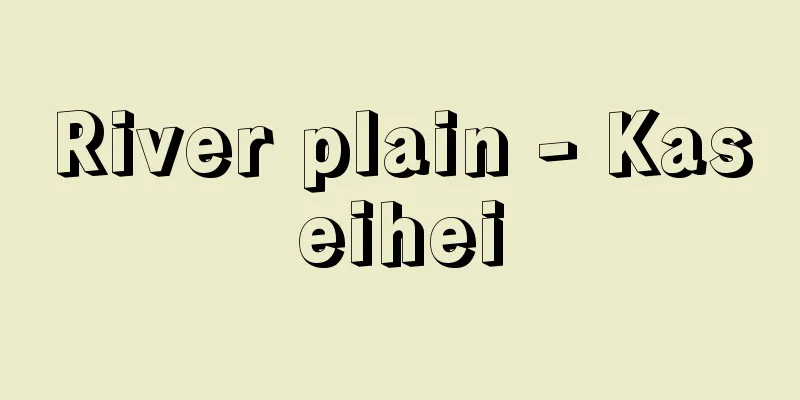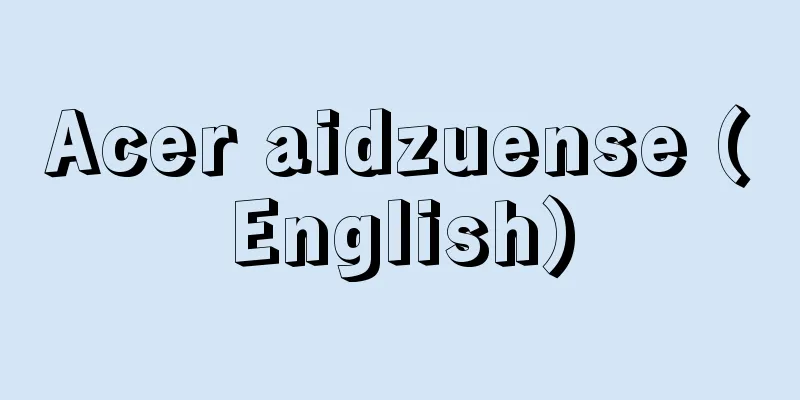River plain - Kaseihei

|
...Originally, any plain formed by the deposition of rivers was called an alluvial plain, regardless of the time of its formation. However, in Japan, the term alluvial plain is often used to refer to plains formed in the most recent geological period, the Alluvial Era (Holocene). This is because the word "alluvial" has the meaning "of the Quaternary Alluvial Era (Holocene)" in addition to its original meaning of "due to deposition by rivers." To prevent such confusion, in recent times, the term "fluvial plain" is sometimes used to distinguish between plains formed by the action of rivers, the low-lying parts of which are called fluvial lowlands, and land that is made of alluvial deposits deposited after the maximum sea level drop of the last glacial period (about 20,000 years ago) and is not very high above the current sea level or riverbed, called alluvial lowlands. For an alluvial plain to form, the conditions for the production of gravel, such as the topography, geology, and vegetation in the upper and middle reaches of the rivers that run through the plain, the conditions for the transport of gravel, such as the forces of the rivers and ocean, and the conditions of the place where the gravel is deposited are all important, and differences in these conditions result in differences in the plain's topography. *Some of the terminology that refers to the "Kawanari Plain" is listed below. Source | Heibonsha World Encyclopedia 2nd Edition | Information |
|
…本来は,形成時期とは関係なく,河川の堆積作用によって形成された平野をさすが,日本では,最も新しい地質時代である沖積世(完新世)に形成された平野を総称して沖積平野とよぶことが多い。これは,〈沖積〉という語が本来の〈河川の堆積による〉という意味のほかに,〈新生代第四紀沖積世(完新世)の〉という意味を持つためで,このような混乱を防ぐため,最近では,河川の作用によって形成された平野を河成平野,そのうち低地の部分を河成低地,最終氷期の最大海面低下期(およそ2万年前)以後に堆積した沖積層から成り,現在の海面や河床からの高さがあまり高くない土地を沖積低地とよんで区別することがある。 沖積平野が形成されるには,平野を流れる河川の上・中流域における地形・地質・植生など砂礫の生産に関する条件,河川や海の営力など砂礫の運搬に関する条件,さらに砂礫が堆積する場所の条件が重要な意味を持ち,これらの条件の違いによって平野の地形に違いが現れる。… ※「河成平野」について言及している用語解説の一部を掲載しています。 出典|株式会社平凡社世界大百科事典 第2版について | 情報 |
Recommend
Chicken (chicken) - Chicken
A poultry of the pheasant family. The red junglefo...
Euler-Poincaré formula - Euler-Poincaré formula
...For a closed surface, (Euler characteristic) =...
Galvanizing - Galvanizing
…In the past, it was also called galvanized steel...
Osteopath
…these columns of lamellae are called the Haversi...
IMC - Integrated Marketing Communications
(1) Because the marketing and communications depar...
Tsuya - Tsuya
In the Heian period, warehouse operators stored an...
Akuritai - I want to do it
… [First half] [Enlargement of the map] Following...
Crime of bribery through mediation
… For the crime of bribery to be established, the...
nucleus loci cerulei (English spelling) nucleus loci cerulei
...When the substantia nigra is damaged for vario...
Price formation - Kakaku Keisei (English spelling) pricing
[Price formation by private companies] The main p...
Gold Use Regulations
...A law (promulgated in 1953) that allowed the g...
Otaki waterfall
This is an old village area in the west of Chichib...
Dryopidae
…General term for insects of the family Dryopidae...
Gill plate - Chorai
… [Respiratory organs of invertebrates] Invertebr...
Folklore - minzokugaku
Folklore studies the development of cultures that...




![Obata [town] - Obata](/upload/images/67cb2150dd551.webp)




